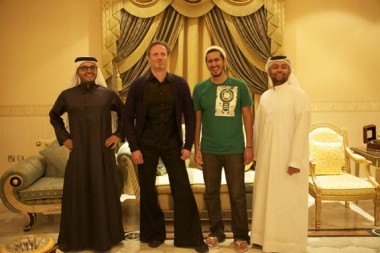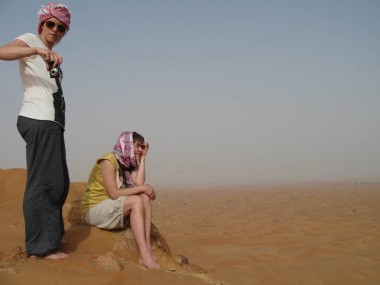Q&A with Rami Farook
Rami Farook, Jurgen Bey, Ahmad Angawi, Omran Al Owais
Rami Farook of traffic is our local partner for Droog al Arab, which we presented in Dubai on May 30th. We asked him a few questions after the presentation.
What motivated you to do this project?
I see design and art as social tools. I always aim to do something with design that is socially progressive, that brings about change.
What was it like to have the team visit you in Dubai?
This trip stood out because we were on a mission. We wanted to encounter as many different kinds of people as we could to try to understand Dubai. I don’t get a chance to meet these people normally.
Take for example the labour camp – the beauty of that situation is that we went to a normal camp and then a five star camp across the street, and we liked the normal one so much more. The five star camp was cleaner and had a television, but it felt corporate, as if it was cut out and pasted, giving it a similar identity crisis that Dubai is having now. The other one was run by the people, it was so much dirtier but they seemed happy.
It was also beautiful the way we ended the trip in the desert—to reflect, to make jokes. Went to a place that was so serene, we were so tired, but had also so much adrenaline.
Nadine Sterk and Saskia van Drimmelen
What kind of potential do you think the platform has?
For us to come out of Dubai with a digital hub is the legacy. The products all came out of collaboration, and then the platform makes it virtual.
What do you think of the on-line bartering concept?
The creative class can exchange ideas. Why should I pay for photography when I can pay for it with graphic design? We should let designers deal with whatever feels more comfortable and exchange with skills and knowledge.
Mark Blaisse considered the platform a metaphor for Dubai’s future. What do you think of this?
Exactly! But, it’s not even the future, it’s the present, the past in Dubai. Dubai has open eyes, they embrace everyone.
Do you think this project says something about the next generation of design?
For me, this is the next generation—the virtual trading of a design process. I see how my generation is different than my father’s. My father’s generation worked to survive and there was a lot of competition. And now we see smaller companies collaborating with one another.


